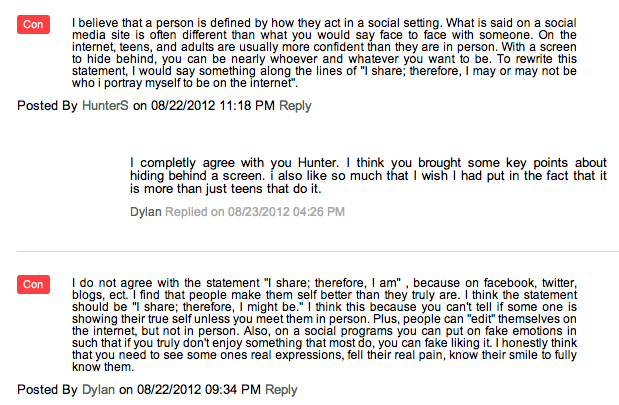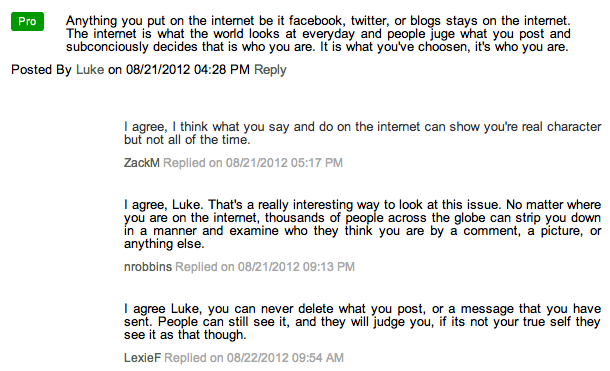I spent my first week of school focusing on communication – the value, the norms and the etiquette associated with different types of communication.
The importance of communication is not stressed enough in conversations about education and the skills students need to be successful beyond school. More often than not, I hear the word “collaboration” stressed as a crucial skill needed for success. I agree the ability to work with others to produce or create something is essential to future success; however, this requires that students are able to communicate effectively first.
This week I wanted my students to begin thinking about how we communicate and how technology is shaping the way we relate to each other and to ourselves.
I began with a “4 Corner Conversations” activity. I posted a discussion prompt in each corner of my room then randomly assigned students to various corners. I asked them to sit together and discuss their topic.
Each corner focused on a different mode of conversation:
- Written
- Text messaging
- Face-to-Face
- Online
Each group discussed the following:
- What are the norms for this type of communication?
- How is this method of communicating different from the others?
- What is considered polite when communicating in this way?
- What is considered rude when communicating in this way?
- How can you avoid miscommunication when communicating via this method?
Each group shared their ideas with the class. I was impressed to hear the groups identifying similarities between different modes of communication. Students also highlighted the way in which online communication has permeated all other types of communication with more formal emails, less formal instant messaging and online face-to-face tools like Skype and Google hangouts.
I showed Sherry Turkle’s TED Talk titled “Connected, but alone?” to get students thinking about how their hyper connectivity may actually be causing them to feel more isolated.
After watching Turkle’s TED Talk, I asked them to share the ideas that impacted them most. These are some highlights from that conversation:
- The photo of Turkle’s daughter and her friends hanging out while all on their cell phones was sad, but many students admitted doing the same thing with their own friends.
- They were disturbed that therapeutic robots were being designed to comfort humans. They felt this reflected poorly on our ability to confort each other.
- Turkle’s statement that people text to have an emotion instead of texting to share an emotion resonated with many of them.
- Many students said they too grabbed their cell phones the minute they were alone, because they are uncomfortable being by themselves.
- They agreed that kids today need to learn how to be alone, as well as how to reflect.
- Many voiced concern that if they are this connected to their devices, what will their kids be like?
I continued this dialogue online for homework. I posted the following debate to my Collaborize Classroom discussion site.
Here is just a snippet of the debate that took place:
In class, we discussed the “Dos and Don’ts of Online Discussions” to ensure our conversations were respectful, supportive and substantive.
- Use each other’s names. Using a person’s name when you respond to his/her postings creates a friendly online tone.
- Read questions and conversational postings carefully to avoid unnecessary confusion.
- Compliment your peers when they post strong responses or contribute original ideas.
- Ask questions. If anything is unclear or you want further information or insight on a topic, just ask. If you have a question, there are probably other members of the group who are confused and need further clarification as well.
- Be considerate. Remember that your peers cannot see your body language or hear your tone of voice, so you need to keep your language direct and respectful.
- Avoid slang, jargon, and sarcasm.
- Listen to all ideas presented. Remember there is no right or wrong in a discussion. A variety of perspectives add depth.
- Stay open minded.
- Respond instead of reacting. Do not write a response if you are angry or upset. Instead, wait until you have had time to calm down and collect your thoughts.
- Really read your peers responses. Avoid skimming. Respect the time your peers have spent articulating their thoughts by reading carefully and thoughtfully.
- Reread your messages before sending them to ensure that your ideas are clearly communicated and supported.
- Critique the content, not the person.
- Do not present your personal opinions as fact. Back up your ideas with information to strengthen your statements.
- Courteously answer all questions addressed directly to you.
- Make I statements when respectfully disagreeing. Sharing an opposing opinion or idea is an important part of discussion, but it needs to be presented in constructive manner that encourages further discussion.
- Do not use all caps when writing. It is interpreted as yelling.
- Avoid emotional punctuation, like exclamation points, unless you are complimenting an idea shared.
I wanted my students to understand the expectations, norms, and etiquette for our online discussions at the start of our work online. Given that there are so many different modes of communication available to students, I felt it was important to explicitly tell them what was appropriate in our work online. I hope this will maintain a safe environment as we work towards developing our communication skills both written and oral, online and face-to-face.
If you have strategies you use to teach communication, please post your ideas!









9 Responses
Thank you for this wonderful post and resources! I really appreciate how clearly you explained exactly what you did with your class! The TED talk was excellent!
I was planning on designing a similar lesson to use with my two new HS English classes, but if you don’t mind me borrowing from your work, then I’d love to take what you have as a base and go from there!
Thank you!
Suzann Keith
Hello Suzann,
Yes, feel free to borrow away! It was a wonderful lesson and the kids really responded to it. I hope it goes well for you too.
Catlin
I love this too and would love to steal it! I’ve watched the Ted Talk before and am always reminded of it when I see a group of teens together but not really. ; )
Great ideas!!
Thank you, Heidi!
[…] feedback mechanism. We’ve worked to establish norms for online communication (thanks to Catlin Tucker’s post). Currently, the student feedback template looks very similar to the teacher feedback form; […]
I love this idea to begin a school year! Today’s students are so technologically connected I fear they will lose the true feeling of face to face communication. I would love to use this, too! Thanks for sharing this.
Diane
You are so welcome, Diane!
While I was reading this article I got excited about the many opportunities which allows student engagement in multiple facets. Although we are teaching virtually, I wanted to begin implementing these strategies immediately. These are great ideals that set tones for diversity in the classroom.
I love it!